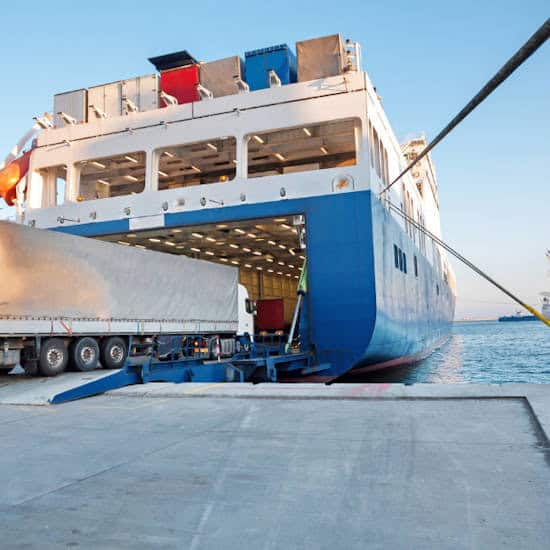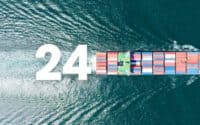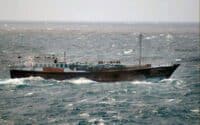Next-Gen Innovations in RORO Cargo Handling and Stowage

Contemporary RORO ships are marvels of engineering. They’re designed with multiple decks and intricate lashing points, ensuring that each vehicle or cargo piece is securely stowed. The focus isn’t just on packing in as many units as possible; it’s about ensuring that each one is safe and unharmed during the journey. This precision is crucial, as RORO ships now carry a diverse range of cargo – from cars to construction equipment, and sometimes even flammable or hazardous materials.
* Please send feedback/suggestions to editor @ shipuniverse.com
Adapting to Modern Needs: The standard practices in today’s RORO cargo handling also reflect the industry’s adaptability. For instance, some ships are equipped with adjustable decks to accommodate taller vehicles. This flexibility ensures that a wide variety of cargo can be transported across the world’s oceans efficiently and safely.
Technological Advancements in Cargo Handling
Revolutionizing RORO: The Age of Automation
Robotic Systems – The New Crew Members: Imagine a fleet of robots efficiently managing the loading and unloading of cargo on a RORO ship. Sounds like sci-fi? Not anymore. Today, robotic systems are increasingly being deployed in RORO cargo handling. These robots are designed to perform repetitive and physically demanding tasks, such as heavy lifting and precise placement of cargo, reducing human error and increasing efficiency.
AGVs – The Unseen Pilots on Deck: Automated Guided Vehicles (AGVs) are another game-changer. These driverless vehicles are programmed to transport cargo around the port and onto the ship. Equipped with sensors and navigation technology, AGVs can maneuver through the tight spaces of a ship’s deck with ease and precision. This not only speeds up the process but also enhances safety by reducing the need for manual driving in confined spaces.
The Art of Lashing: Advanced Systems for Cargo Security
Beyond Traditional Ropes: Lashing cargo in a RORO ship is an art, and technology is refining this art. Advanced lashing systems have emerged, moving beyond ropes and chains to sophisticated mechanisms. These systems use hydraulic or mechanical components to secure cargo quickly and more reliably. This advancement is crucial, especially when dealing with heavy or oversized cargo that requires extra stability.
Efficiency Meets Safety: These advanced systems are not just about strength; they’re designed to be user-friendly and time-saving. They reduce the physical strain on workers and the time taken to secure cargo, ensuring that ships can depart and arrive on schedule.
Smart Shipping: IoT and AI in RORO Operations
IoT – The Network of Efficiency: The Internet of Things (IoT) is bringing a level of connectivity to RORO shipping that was previously unimaginable. Sensors placed on cargo, within the ship, and throughout the port collect real-time data on everything from cargo conditions to the ship’s environment. This data allows for constant monitoring and quick response to any issues that arise during transit.
AI – The Brain Behind Operations: Artificial Intelligence (AI) takes this a step further. It analyzes the vast amounts of data collected by IoT sensors to optimize routes, predict maintenance needs, and even assist in stowage planning. AI algorithms can quickly calculate the most efficient arrangement of cargo, taking into account weight distribution, destination, and unloading order. This not only speeds up the loading and unloading process but also enhances safety by ensuring optimal balance and stability.
Innovations in Stowage Techniques
The Digital Blueprint: Computer-Aided Stowage Planning
Perfecting the Puzzle with Technology: Stowage planning in RORO shipping is like playing a high-stakes game of Tetris, where every square foot counts. Computer-aided stowage planning has revolutionized this process. With sophisticated software, planners can now create 3D models of cargo spaces and simulate the loading process before the ship even arrives at port. This not only maximizes space utilization but also significantly reduces the time spent in port.
Predictive Precision: These programs can factor in variables like weight distribution, cargo type, and final destination to ensure optimal balance and efficiency. This foresight minimizes the risk of cargo shifting during transit, a critical safety concern, especially in rough sea conditions. The result? Faster loading and unloading, safer transport, and more efficient use of vessel space.
Tailoring Spaces: Modular Stowage Solutions
One Size Does Not Fit All: The diversity of cargo that RORO ships carry today demands flexibility in stowage solutions. Enter modular stowage systems – the answer to this diverse range of cargo needs. Think of these systems like adjustable shelves in a cupboard, but on a much grander scale. They allow for compartments within the ship to be reconfigured to accommodate different sizes and types of cargo, from standard vehicles to oversized equipment.
Adapting to Change: This adaptability is crucial in responding to the ever-changing demands of global trade. Whether it’s a sudden spike in demand for vehicle transport or the need to accommodate larger, heavier industrial equipment, modular stowage systems allow RORO ships to adjust quickly and efficiently.
Heavy-Duty Handling: Safety Enhancements in Stowage
The Weighty Challenge: Heavy and oversized cargo presents unique challenges in stowage. It’s not just about space; it’s about safety. Improperly stowed heavy cargo can lead to instability and even accidents.
Strength and Stability: To tackle this, new stowage techniques and equipment have been developed. Enhanced lashing points and stronger securing materials ensure that heavy items remain immobile during transit. In addition, specialized loading equipment and strengthened deck areas are used to handle the extra weight without compromising the integrity of the vessel.
A Focus on Training: Alongside these hardware innovations, there’s an increased emphasis on crew training. Handling heavy cargo safely requires skill and knowledge, from understanding the physics of weight distribution to operating heavy-lifting equipment.
Integration of Digital Tools
Cutting Through the Paper: Digital Documentation and E-Bills of Lading
Going Paperless on the High Seas: In an industry historically buried in paperwork, the shift to digital documentation and e-bills of lading is nothing short of revolutionary. These digital tools streamline the entire paperwork process, making it faster, more accurate, and far less cumbersome. Gone are the days of mountains of paperwork for each shipment. Now, all necessary documents are just a few clicks away, accessible from anywhere in the world.
Efficiency and Security: Not only does this shift save time and reduce the risk of errors, but it also enhances security. Digital documents are harder to forge and easier to track, adding an extra layer of protection against fraud. Plus, the environmental impact of reducing paper use is a significant bonus, aligning with the industry’s growing focus on sustainability.
Beyond Location – Monitoring Conditions: These systems don’t just track location; they monitor conditions like temperature, humidity, and even shock or impact. This is crucial for sensitive cargo, ensuring that it remains in optimal conditions throughout its journey.
Anticipating the Future: Predictive Maintenance
Preventing Failures Before They Happen: One of the most exciting applications of digital technology in RORO shipping is predictive maintenance. By using data analytics, ship operators can anticipate equipment failures before they occur. Sensors throughout the ship collect data on various parameters like vibration, temperature, and pressure.
Data-Driven Decisions: This data is then analyzed to identify patterns or anomalies that could indicate a potential problem. By addressing these issues proactively, predictive maintenance can significantly reduce downtime and prevent costly and disruptive equipment failures.
Cost-Effective and Safe: This not only saves money in the long run but also enhances safety onboard. Regular maintenance is crucial in the maritime industry, and being able to predict and prevent issues adds an invaluable layer of security.
Future Trends and Predictions
Navigating Towards Tomorrow: Emerging Technologies on the Horizon
The Next Wave of Innovation: The RORO industry, already riding the high seas of technological advancement, is set to embrace even more groundbreaking innovations. Here’s a peek at what’s on the horizon:
- Autonomous Ships: Think self-driving cars, but on a massive scale. Autonomous ships, guided by AI and sophisticated navigation systems, could revolutionize RORO operations by increasing efficiency and reducing human error.
- Advanced Robotics: Beyond current robotic applications, future RORO ships might see more advanced robotic arms and drones, capable of handling a wider range of tasks, from intricate loading to complex maintenance jobs.
- 3D Printing at Sea: Imagine printing spare parts right on the ship! This could drastically reduce the need for carrying extensive inventories, freeing up valuable cargo space and reducing turnaround times.
- Blockchain in Logistics: Blockchain technology has the potential to further streamline the documentation process, making it more transparent and secure, and improving coordination among the various stakeholders.
Shaping the Future: How These Innovations Will Transform RORO Cargo Handling and Stowage
The Efficiency Revolution: With autonomous ships and advanced robotics, the efficiency of RORO cargo handling and stowage is poised to reach new heights. These technologies could lead to faster turnaround times, reduced labor costs, and minimized human error, resulting in more reliable and timely shipping services.
Safety and Sustainability: Innovations like 3D printing and blockchain are not just about efficiency; they also promise enhanced safety and sustainability. With the ability to produce parts on demand, ships can maintain optimal operation without excess weight. Blockchain, on the other hand, ensures a more transparent and environmentally responsible supply chain.
Customization and Flexibility: As technology evolves, so too will the ability to customize RORO services for diverse cargo types. This means more tailored solutions for customers and an ability to adapt quickly to changing market demands.
The Human Element: It’s important to remember that while technology advances, the role of skilled professionals remains crucial. Training and adaptation will be key, as the workforce evolves alongside these new tools and systems.
These innovations promise not just improved operational efficiency but also greater sustainability, safety, and adaptability in the face of global trade’s ever-changing landscape. As we sail into this future, the RORO industry stands ready to embrace these exciting new developments, charting a course towards a more efficient, safe, and dynamic future.
Additional References
- Journal of Commerce – Provides valuable information and updates on RORO cargo and related maritime industry news.
- SMM Hamburg – The world’s leading exhibition for the maritime industry, including the RORO shipping sector.
- The Maritime Executive – Offers in-depth understanding and insights into deep-sea RORO shipping.
- Seatrade Maritime – Discusses shipping industry trends to look out for in 2024, potentially relevant for RORO shipping professionals.
- Automotive Logistics – Provides a global report on the RORO industry, discussing market dynamics and trends.

Do you have a Maritime Product or Service that may be of interest to Shipowners? Tell us about it here!
Do you have feedback or insights? Please reach out to editor @ shipuniverse.com



